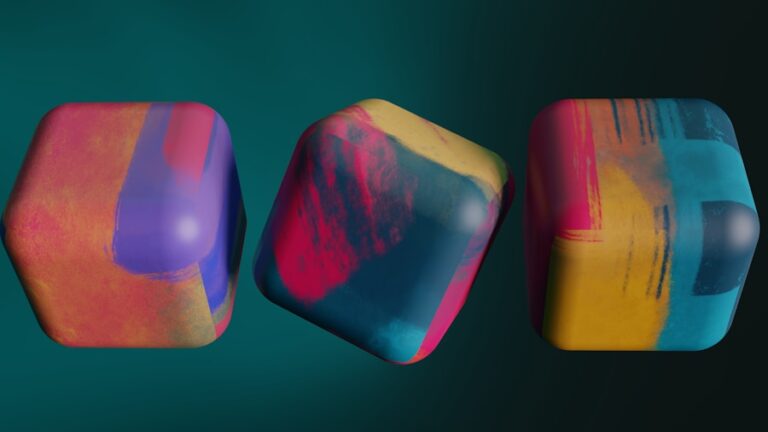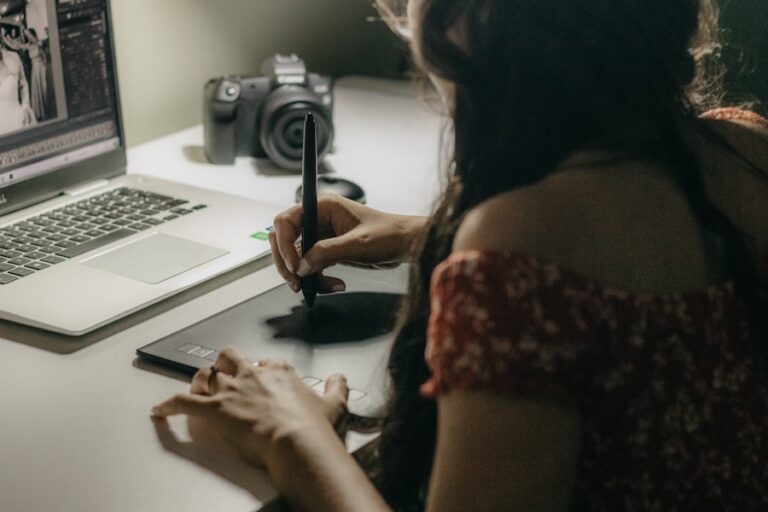Unveiling the Beauty of Digital Art Aesthetics: A Deep Dive
Digital art has come a long way since its inception, evolving from simple pixelated images to complex and intricate masterpieces. In the early days of digital art, artists were limited by the capabilities of the technology, often creating works that were rudimentary and lacking in detail. However, as technology advanced, so did the possibilities for digital art. With the development of high-resolution displays and powerful software tools, artists were able to create stunning and realistic digital paintings, sculptures, and animations that rivaled traditional art forms.
The evolution of digital art has also been shaped by the rise of social media and online platforms, which have provided artists with new ways to showcase and distribute their work. This has led to a democratization of the art world, allowing artists from all backgrounds to gain recognition and exposure for their digital creations. As a result, digital art has become increasingly mainstream, with digital artworks being featured in galleries, museums, and even sold at auction for significant sums. The evolution of digital art has truly transformed the way we perceive and appreciate artistic expression, opening up new possibilities for creativity and innovation.
Understanding Digital Art Aesthetics: Composition, Color, and Texture
Digital art aesthetics encompass a wide range of elements that contribute to the overall visual impact of a digital artwork. Composition, color, and texture are three key components that play a crucial role in shaping the aesthetic appeal of digital art. Composition refers to the arrangement of visual elements within a digital artwork, including the placement of objects, the use of negative space, and the overall balance and harmony of the piece. A well-composed digital artwork will draw the viewer’s eye in and create a sense of visual flow that guides the viewer’s gaze through the piece.
Color is another important aspect of digital art aesthetics, as it can evoke emotions, set the mood, and create a sense of depth and dimension within a digital artwork. Artists use color theory to create harmonious color palettes that enhance the overall impact of their work. Texture is also a crucial element in digital art aesthetics, as it can add depth and tactile quality to a digital artwork. Whether it’s through the use of brush strokes in a digital painting or the manipulation of pixels in a digital photograph, texture can create a sense of realism and physicality that engages the viewer on a sensory level. Understanding these elements and how they interact with each other is essential for creating visually compelling digital art that resonates with viewers on an emotional and aesthetic level.
Exploring the Intersection of Technology and Creativity in Digital Art
The intersection of technology and creativity has been a driving force behind the evolution of digital art aesthetics. Advances in technology have provided artists with new tools and techniques for creating digital art that were previously unimaginable. From digital painting software that simulates traditional mediums to 3D modeling programs that allow artists to sculpt virtual objects with precision, technology has expanded the possibilities for artistic expression in the digital realm. This has led to a renaissance in digital art, with artists pushing the boundaries of what is possible and redefining the medium in exciting new ways.
At the same time, technology has also democratized the creation of digital art, making it more accessible to a wider audience. With the rise of affordable tablets, styluses, and software applications, anyone with a creative spark can try their hand at digital art. This has led to a flourishing community of digital artists who are constantly experimenting with new techniques and styles, pushing the medium forward in unexpected directions. The intersection of technology and creativity has not only transformed the way we create and consume digital art but has also opened up new avenues for collaboration and innovation in the artistic community.
The Impact of Digital Art Aesthetics on Visual Communication and Design
Digital art aesthetics have had a profound impact on visual communication and design, shaping the way we perceive and interact with visual information in our daily lives. From advertising and branding to user interface design and multimedia storytelling, digital art aesthetics play a crucial role in shaping our visual experiences. The use of color, composition, and texture in digital art can influence how we interpret and respond to visual stimuli, whether it’s a logo, a website layout, or an animated video.
In the realm of advertising and branding, digital art aesthetics are used to create compelling visuals that capture attention and convey a brand’s identity and message. The use of vibrant colors, dynamic compositions, and engaging textures can make a brand stand out in a crowded marketplace and leave a lasting impression on consumers. In user interface design, digital art aesthetics are used to create intuitive and visually appealing interfaces that enhance the user experience and make interactions with technology more enjoyable and engaging. In multimedia storytelling, digital art aesthetics are used to create immersive and emotionally resonant experiences that captivate audiences and convey complex narratives in visually compelling ways. The impact of digital art aesthetics on visual communication and design is undeniable, shaping the way we engage with visual information in an increasingly digital world.
Unveiling the Beauty of Digital Art: Examining the Role of Emotion and Expression
At its core, digital art is a form of creative expression that seeks to evoke emotion and connect with viewers on a deep and personal level. Digital art aesthetics play a crucial role in shaping the emotional impact of a piece, influencing how viewers respond to the work and what kind of emotional experience it elicits. Whether it’s through the use of color to create a sense of warmth or coolness, composition to create a sense of balance or tension, or texture to create a sense of depth or tactility, digital art aesthetics are used to convey emotion and expression in powerful ways.
The beauty of digital art lies in its ability to transcend traditional boundaries and push the limits of what is possible in artistic expression. Through the use of technology, artists are able to create works that are not bound by the constraints of physical materials or traditional techniques, allowing for an unprecedented level of freedom and experimentation. This has led to an explosion of diverse styles and approaches within the realm of digital art, with artists exploring new ways to convey emotion and expression through their work. Whether it’s through hyper-realistic digital paintings that evoke a sense of awe and wonder or abstract digital sculptures that challenge our perceptions of form and space, digital art continues to unveil new possibilities for emotional connection and expression.
The Future of Digital Art Aesthetics: Trends and Innovations
As technology continues to advance at an exponential rate, the future of digital art aesthetics is filled with exciting possibilities and innovations. From advancements in virtual reality and augmented reality technology to developments in artificial intelligence and machine learning, the tools and techniques available to digital artists are constantly evolving. This has led to new trends and movements within the world of digital art, as artists explore new ways to harness technology to create immersive and interactive experiences that push the boundaries of what is possible.
One emerging trend in digital art aesthetics is the use of generative algorithms and procedural techniques to create dynamic and ever-evolving artworks that respond to user input or environmental stimuli. This has led to the rise of interactive installations and experiences that blur the line between art and technology, inviting viewers to become active participants in the creation of the artwork. Another trend is the integration of traditional artistic mediums with digital tools, as artists combine techniques such as painting, sculpture, and photography with digital processes to create hybrid works that bridge the gap between physical and virtual realms. These trends are just a glimpse of what the future holds for digital art aesthetics, as artists continue to push the boundaries of what is possible through innovation and experimentation.
Embracing Diversity in Digital Art Aesthetics: Celebrating Different Styles and Perspectives
One of the most exciting aspects of digital art aesthetics is the diversity of styles and perspectives that it encompasses. From hyper-realistic digital paintings to abstract 3D sculptures to interactive multimedia installations, there is no shortage of variety within the world of digital art. This diversity reflects the wide range of influences and inspirations that artists draw from, whether it’s traditional artistic movements, cultural heritage, personal experiences, or technological innovation.
Embracing diversity in digital art aesthetics means celebrating different styles and perspectives, recognizing that there is no one-size-fits-all approach to creating compelling digital artwork. It means acknowledging that beauty can be found in both photorealistic renderings and minimalist abstractions, in meticulously crafted compositions and spontaneous improvisations. By embracing diversity in digital art aesthetics, we open ourselves up to new ways of seeing and experiencing the world around us, expanding our understanding of what is possible in artistic expression.
In conclusion, the evolution of digital art from its humble beginnings to its current state as a vibrant and diverse medium has been shaped by advancements in technology, changes in artistic practices, shifts in cultural attitudes towards creativity, as well as innovations in visual communication design. Understanding digital art aesthetics involves recognizing how composition, color, texture intersect with technology creativity; appreciating how they impact visual communication design; unveiling their role in evoking emotion expression; exploring future trends innovations; embracing diversity celebrating different styles perspectives within this dynamic field. As we continue to push the boundaries of what is possible through innovation experimentation within this dynamic field we can look forward to an exciting future filled with new possibilities for artistic expression through technology.





